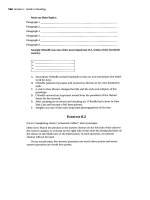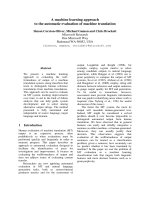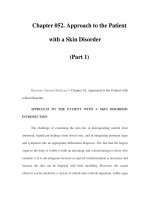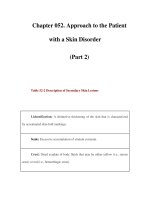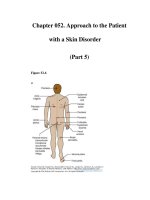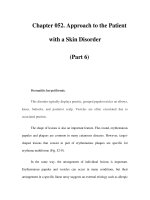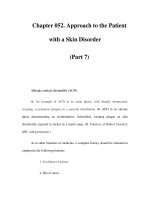Chapter 077. Approach to the Patient with Cancer (Part 12) pot
Bạn đang xem bản rút gọn của tài liệu. Xem và tải ngay bản đầy đủ của tài liệu tại đây (13.43 KB, 5 trang )
Chapter 077. Approach to the
Patient with Cancer
(Part 12)
Death and Dying
The most common causes of death in patients with cancer are infection
(leading to circulatory failure), respiratory failure, hepatic failure, and renal
failure. Intestinal blockage may lead to inanition and starvation. Central nervous
system disease may lead to seizures, coma, and central hypoventilation. About
70% of patients develop dyspnea preterminally. However, many months usually
pass between the diagnosis of cancer and the occurrence of these complications,
and during this period the patient is severely affected by the possibility of death.
The path of unsuccessful cancer treatment usually occurs in three phases. First,
there is optimism at the hope of cure; when the tumor recurs, there is the
acknowledgment of an incurable disease, and the goal of palliative therapy is
embraced in the hope of being able to live with disease; finally, at the disclosure of
imminent death, another adjustment in outlook takes place. The patient imagines
the worst in preparation for the end of life and may go through stages of
adjustment to the diagnosis. These stages include denial, isolation, anger,
bargaining, depression, acceptance, and hope. Of course, patients do not all
progress through all the stages or proceed through them in the same order or at the
same rate. Nevertheless, developing an understanding of how the patient has been
affected by the diagnosis and is coping with it is an important goal of patient
management.
It is best to speak frankly with the patient and the family regarding the
likely course of disease. These discussions can be difficult for the physician as
well as for the patient and family. The critical features of the interaction are to
reassure the patient and family that everything that can be done to provide comfort
will be done. They will not be abandoned. Many patients prefer to be cared for in
their homes or in a hospice setting rather than a hospital. The American College of
Physicians has published a book called Home Care Guide for Cancer: How to
Care for Family and Friends at Home that teaches an approach to successful
problem-solving in home care. With appropriate planning, it should be possible to
provide the patient with the necessary medical care as well as the psychological
and spiritual support that will prevent the isolation and depersonalization that can
attend in-hospital death.
The care of dying patients may take a toll on the physician. A "burnout"
syndrome has been described that is characterized by fatigue, disengagement from
patients and colleagues, and a loss of self-fulfillment. Efforts at stress reduction,
maintenance of a balanced life, and setting realistic goals may combat this
disorder.
End-of-Life Decisions
Unfortunately, a smooth transition in treatment goals from curative to
palliative may not be possible in all cases because of the occurrence of serious
treatment-related complications or rapid disease progression. Vigorous and
invasive medical support for a reversible disease or treatment complication is
assumed to be justified. However, if the reversibility of the condition is in doubt,
the patient's wishes determine the level of medical care. These wishes should be
elicited before the terminal phase of illness and reviewed periodically. Information
about advance directives can be obtained from the American Association of
Retired Persons, 601 E Street, NW, Washington, DC 20049, 202-434-2277 or
Choice in Dying, 250 West 57th Street, New York, NY 10107, 212-366-5540. A
full discussion of end-of-life management is in Chap. 11.
Further Readings
Grunberg SM, Hesketh PJ: Control of chemotherapy-
induced emesis. N
Engl J Med 329:1790, 1993 [PMID: 8232489]
Jemal A et al: Cancer statistics, 2007. CA Cancer J Clin 57:43, 2007
[PMID: 17237035]
Kamangar F
et al: Patterns of cancer incidence, mortality, and prevalence
across five continents: Defining priorities to reduce cancer disparities in different
geographic regions of the world. J Clin Oncol 24:2137, 2006 [PMID: 16682732]
Levy MH: Pharmacologic treat
ment of cancer pain. N Engl J Med
335:1124, 1996 [PMID: 8813044]
Therasse P et al: New guidelines to evaluate response to treatment in solid
tumors. J Natl Cancer Inst 92:205, 2000 [PMID: 10655437]
U.S. Department of Health and Human Services: Clinical
Practice
Guideline Number 9, Management of Cancer Pain
. U.S. Department of Health and
Human Services, Agency for Health Care Policy and Research publication no. 94-
0592, 1994
Walsh D et al: The symptoms of advanced cancer: Relationship to age,
gender, an
d performance status in 1000 patients. Support Care Cancer 8:175, 2000
[PMID: 10789956]

